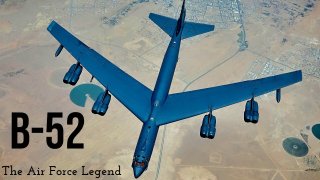B-52 Stratofortress: The Ancient U.S. Air Force Bomber That Even Time Can't Stop
The Cold War-era B-52 has been in service far longer than its current aircrews have been alive, and it could remain in service until the 2040s or later thanks to numerous upgrades during its service life. By the time the massive aircraft are finally retired, they could be crewed by the great-grandchild of the first to sit at the controls and stations onboard.
The longest commercial flight in the world today is from New York City's John F. Kennedy International Airport (JFK) to Singapore Changi (SIN). At 9,526 miles (15,332 km), this route takes an average of 18 hours and 40 minutes to complete. Travelers on board could get a full nine hours of sleep and that is only half the time they'll be in the air.
Yet, that route has nothing on the distance that some military pilots are known to fly. The United States Air Force routinely deploys its long-range strategic bombers on CONUS-to-CONUS missions, meaning they travel from their home base in the middle of America to Europe or Asia and back. While they can see the sights from the air, they don't even get to sample the local cuisine.
That wasn't the case last week, however, for a pair of United States Air Force B-52 Stratofortress bombers assigned to the 2nd Bomb Wing from Barksdale Air Force Base (AFB), Louisiana. Those two aircraft made a 30-hour one-way flight to Naval Support Facility Diego Garcia, located on the British Indian Ocean Territory, as part of a Bomber Task Force deployment. It was aimed to enhance the readiness and training necessary to respond to any potential crisis or challenge across the globe, while further demonstrating the credibility of the U.S. Air Force to address a global security environment.
"Bomber task force missions showcase our capability for rapid deployment in support of the combatant commander?s objectives," said Maj. Joshua Dawkins, 96th Bomb Squadron director of operations.
Strategically located in the heart of the Indian Ocean, Diego Garcia provides a key platform for U.S. military operations, enabling rapid response capabilities across the vast Indo-Pacific region, the Air Force announced. The Naval Support Facility has hosted American troops since the 1970s.
B-1B Lancer bombers were deployed to the remote island in 2021, while the B-52 last visited the tropical island in 2020. The islands are in the U.S. Indo-Pacific Command's area of responsibility, yet, the Air Force has used it as a staging area to send bombers into the U.S Central Command's area of operations. The deployment also comes as B-52s from Minot AFB were deployed to Guam from the end of January until earlier this month.
The Cold War-era B-52 has been in service far longer than its current aircrews have been alive, and it could remain in service until the 2040s or later thanks to numerous upgrades during its service life. By the time the massive aircraft are finally retired, they could be crewed by the great-grandchild of the first to sit at the controls and stations onboard.
Throughout its already impressive seven decades in service, the aircraft has been steadily upgraded. This has included everything from the installation of Raytheon?s AESA AN/APG-79 radar to the addition of new navigation and communication systems and even the installation of a privacy screen for the aircraft's single lavatory.
Though 744 were built, with the final aircraft being delivered in October 1962, there are currently 76 in the United States Air Force?s inventory. Of those 58 are active with the 2nd Bomb Wing and 5th Bomb Wing, while 18 more are in reserve with the 307th Bomb Wing. Another dozen are in long-term storage at the Davis-Monthan AFB "Boneyard."
Thanks to the upgrades, the B-52 will keep logging miles around the world.
Author Experience and Expertise: Peter Suciu
Peter Suciu is a Michigan-based writer. He has contributed to more than four dozen magazines, newspapers, and websites with over 3,200 published pieces over a twenty-year career in journalism. He regularly writes about military hardware, firearms history, cybersecurity, politics, and international affairs. Peter is also a Contributing Writer for Forbes and Clearance Jobs. You can follow him on Twitter: @PeterSuciu.
You can email the author or contact the publication: [email protected].


